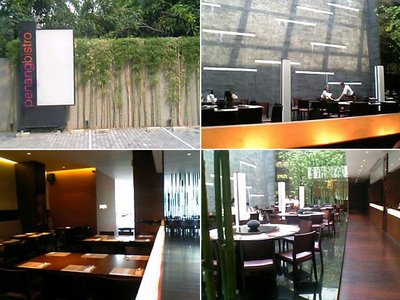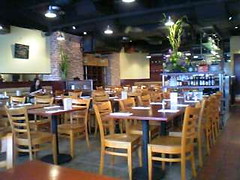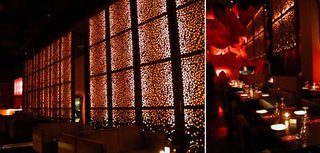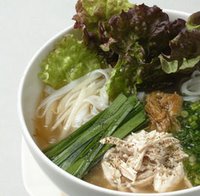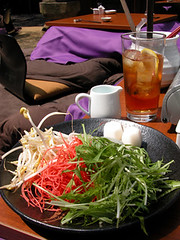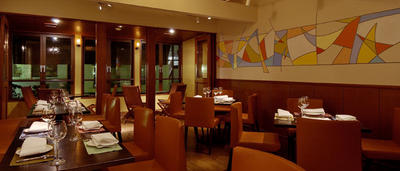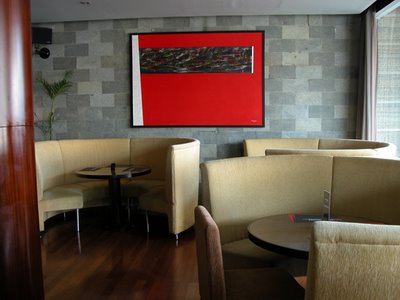While my compatriots in the United States are frantically finishing their income tax reports and filings, I took a casual stroll today to a favorite, nearby complex of restaurants that was the Hanezawa Garden.
I recently realized that during the warmer weather of Spring, Summer and early Fall (from April until October), the outdoor dining at the Hanezawa Garden offered Korean BBQ, but once the colder breeze reached the city, the main and
only attraction at this al-fresco dining became the shabu-shabu. Today becomes the last day to have a taste of that traditional winter fare, as tomorrow, the restaurant will be closed for a wedding. Next week, the Korean BBQ will once again reign as the sole performer at this part of the restaurant. The word shabu-shabu is a Japanese onomatopoeia for the sound that the meat makes as it is being moved through the water. It is the English equivalent of "swish-swish."
A small appetizers: a trio of mini bite-size fish, tiny slice of a rolled crepe and greens with miso, accompanied by a small bowl of fish in hot broth started the dining experience.
For the main course, there are only two choices in the shabu-shabu menu: pork or beef. Unlike other traditional shabu-shabu places that offer different grades of the beef, Hanezawa offers only one simple kind, but judging by the taste, it seems that the restaurant serves only the best. Oscar Wilde would have approved.
The vegetable plate was rather a pared down version of the same plate at other shabu-shabu places, but for just one person dining, it was enough for me. The presentation was rather lacking as compared to that of the complex's main dining room's.
Although I was provided with the means to clear the broth, it would have been nice to have that extra touch of service when someone from the restaurant would come by and clear it for you, as is the case at the Shabu Zen restaurant. Also, the udon at the end of the meal was presented for myself to mix with the broth instead of someone (again, at Shabu Zen) coming to prepare it for you at the table. It seems to me that there is more attention paid when one dines at the main dining hall.
Without asking, I can safely assume that the beef was domestic top premium grade. Sliced very thinly, the beef took just less than 3 seconds to become medium rare, and a full 7 seconds to reach well-done.
I am glad to have caught this menu before it goes into a seasonal hibernation. Until it wakes up again late next Fall, I can always review my pictures to remind me of how good a lunch it has been today.
(For another version of the trip to this restaurant, please consult http://bloompy.blogspot.com)
[UPDATED NEWS: December 20, 2005]
Sadly, the Hanezawa Garden has recently closed (December 17, 2005) due to aging facility. The architecture has been in existence since 1915. I have decided to keep this review here for sentimental reasons.


